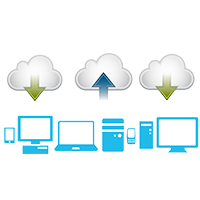There are several aspects to consider when choosing to implement a fully integrated inventory and accounting (ERP) system - one of them being whether or not to implement the software via the cloud or as an on-premises solution. The term "cloud" is often used interchangeably with the terms "hosted" and "SaaS", and refers to the deployment method whereby the client pays the vendor an ongoing “subscription” fee for access to the software (off-premises) via the Internet. The vendor takes care of maintaining hardware, upgrades and backups. In contrast, on-premises implementations are installed on the client’s server, on-site and the hardware is managed by the client.
Cloud vs On-Premises
Cloud implementations have made it more affordable for small businesses and start-ups to implement a proper ERP system with advanced automation, systems that were historically only available to larger organizations with deep pockets. But without performing additional research, there is no simple answer as to which method is better suited for any specific business.
Choosing an implementation method is dependent on many factors, among them: cash flow, number of users, available hardware, existing infrastructure, physical space, IT skills, level of desired hardware control and internet connection. Smaller businesses and start-ups tend to lean towards cloud implementations because of their ongoing, monthly payment structure — an affordable and predictable cash flow. On-Premises implementations require an up-front investment that is much more substantial but may be a better fit for businesses with an existing IT infrastructure and IT staff. Costs to consider include license fees, maintenance fees, implementation costs, external consulting and customization costs, infrastructure upgrade costs and internal costs.
Because the vendor for cloud implementations hosts the software, the client does not handle upgrades, maintenance, IT issues or backups. This is beneficial for smaller businesses that lack an IT department. However, businesses that prefer to own the software and control the hardware will lean towards an on-premises solution.
To learn more about which implementation is best for your business, and to compare real-life examples of the costs, download our guide:









